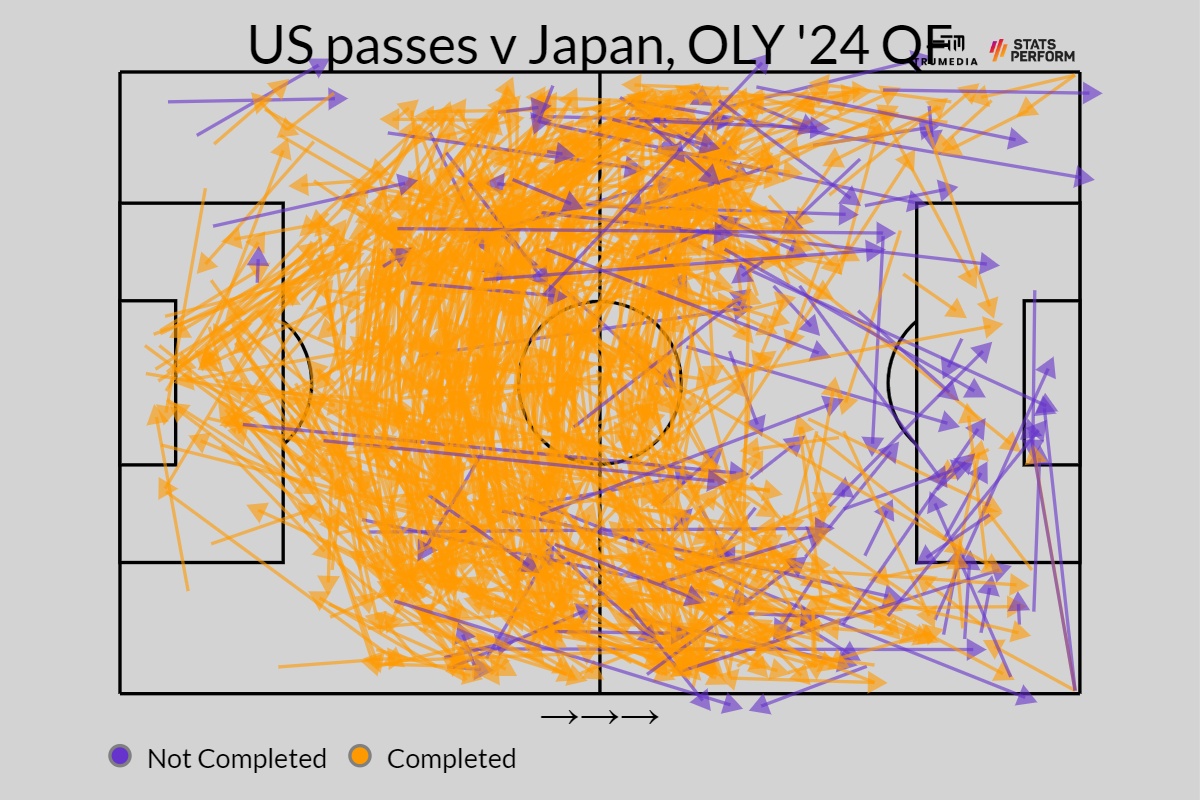For 106 minutes, the United States and Japan slogged through their 2024 Olympic women’s soccer quarterfinal to the point of occasional jeers from the crowd due to the slow, passive nature of the game. To call it a chess match would be generous; tactical wit was offset by technical lapses that prevented a breakthrough.
Then came the inevitable: Trinity Rodman.
Rodman collected a long diagonal ball — a tactic the USWNT largely avoided prior to that — from Crystal Dunn, then cut inside of Japan defender Hikaru Kitagawa and smashed a left-footed shot into the far upper corner to clinch a 1-0 victory.
The goal sent the Americans through to the semifinals and guarantees they will play for a medal next week. It was also a reward for USWNT head coach Emma Hayes’ insistence on patience and steadfast desire to stick with her trusted core of players despite the three-day turnaround of the Olympic matches. The approach produced a performance unlike any other on record for a U.S. team known to play direct and thrive in transition.
The USWNT finished the match with 1,026 passes attempted, the most in a game by any team in either of the last three Olympics or last four World Cups, per ESPN Stats & Information. (Spain set the previous mark with 925 vs. Japan earlier at these Olympics.) Prior to Saturday, the USWNT’s previous high mark for attempted passes in a match over that same time was 649, in a 13-0 win over Thailand at the 2019 World Cup.
Saturday could be seen as the turning point in the Americans’ identity, and it has been forged by familiar protagonists.
Hayes made just one change to her starting lineup again, inserting Korbin Albert — who hit a stunning game-winning goal against Australia on Wednesday — into the holding midfield role in place of the suspended Sam Coffey. Emily Sonnett started at center-back again in place of the injured Tierna Davidson. The USWNT used the least amount of rotation in an Olympics since the 2000 Games, a trend that continued as Hayes opted not to make a substitution through regulation.
Japan set up in a compact 5-4-1 defensive shape that challenged the Americans to find an individual moment of brilliance and precision to break through. The task was similar to the one faced three days earlier against Australia, except Japan is a more talented and disciplined side.
It resulted in a slog of a match.
The USWNT held 70% possess and attempted over 1,000 passes, numbers that Japan happily conceded as the USWNT probed laterally without causing problems going forward. The Americans’ 31 touches inside the opponent’s box and 0.69 expected goals, per TruMedia, only marginally bettered Japan, which was happy to sit back and find individual moments on the counterattack.

The most clear-cut opportunities of the first half came from Japan 35 minutes into the match, first when Mina Tanaka separated from Lindsey Horan in the box but scuffed a shot, then a minute later on a counterattack that ended with Miyabi Moriya skying her volley over the bar.
This was precisely the type of game Hayes had warned about, one that tested the USWNT’s new identity to its core. For years, the Americans met low blocks — from talented and inferior teams alike — with a sense of palpable frustration and impatience, often lumping balls forward.
Hayes, who had faced plenty of disciplined defensive opponents in her previous 12 years at Chelsea, has preached restraint. The USWNT was patient to a fault at times on Saturday, settling for lateral passes at speeds too slow to pull Japan out of shape.
USWNT center-back Naomi Girma played 105 passes in the first half alone, more than any other player in an entire knockout game of a World Cup or Olympics dating back to 2011, when Opta started measuring.
Saturday was the embodiment of everything Hayes and her players have said they would do. Still, it required a moment of brilliance from Rodman to secure a result and prevent the result from being decided in a penalty shootout.
Rodman has been the USWNT’s most reliable attacking player, contributing a goal or an assist in all four Olympic matches (a first for the USWNT since 2012, per Opta) and continuing her streak as the only player to have appeared in every match for the team since the start of 2023.
Her goal on Saturday made her the youngest USWNT player to score in a knockout-round game of the Olympics since 20-year-old Lindsay Tarpley scored in the 2004 gold-medal game.
The challenge ahead is now also oddly familiar to the one that loomed after Wednesday’s final whistle: what are the implications of the USWNT’s scarce rotation come the semifinals against Germany (who the Americans defeated 4-1 in the group stage) or old foe Canada? Part of Saturday’s slow game state and heavy touches could undoubtedly be credited to heavy legs from USWNT players.
Coffey will return from suspension, while Davidson’s health remains in question. Jaedyn Shaw made the game day roster (which had only 17 players due to Coffey’s ban) on Saturday for the first time this tournament and could offer fresh, creative legs in the semifinal.
Those worries are for Sunday, as Hayes surely told her players and anyone who would listen after the match. One game at a time has been the message from Hayes, and the USWNT is now playing for a medal, which was always the benchmark to reach coming into these Games for a team in transition.
They slogged through Saturday’s quarterfinal, but in a unique way. As docile as it might have seemed at times, it was also the progress the Americans have been seeking.
